
Brainstorm Security Shop

For Orders Over $199

On Any Of Our Products

Details On Refund Page
You’ve likely come across various throwing stars, but have you ever considered the importance of their durability? When you choose a star crafted from high-quality materials like steel alloys or titanium, you’re investing in a piece that not only withstands rigorous use but also maintains its performance through time. However, the real question is, do you know how to spot the difference between a genuinely durable star and one that merely looks the part? Let’s explore the nuances that set apart the elite from the ordinary in the world of throwing stars.
While throwing stars, or shuriken, are often associated with the shadowy world of the ninja, their origins are more multifaceted and rooted in ancient Japanese warfare techniques. You mightn’t know that the use of these intriguing tools dates back to the medieval era, where they weren’t just weapons but tools for distraction and misdirection.
The throwing star origins tie deeply with the strategies employed by samurai and ninjas alike, each valuing the element of surprise and psychological advantage that shuriken could provide.
As you explore their historical journey, you’ll find that throwing stars held significant cultural significance. They weren’t merely tools of war; they symbolized the ingenuity and tactical acumen of those who wielded them.
In a society bound by rigorous codes and martial discipline, the shuriken became a symbol of resistance and cunning. They were often hidden, reflecting the secretive lives of their users, and their designs were tailored to be as discreet as they were deadly.
Understanding this, you’re not just looking at a piece of sharpened metal but a profound emblem of a warrior’s resourcefulness and cultural heritage.
These stars tell a story of survival, innovation, and the art of silent victory.
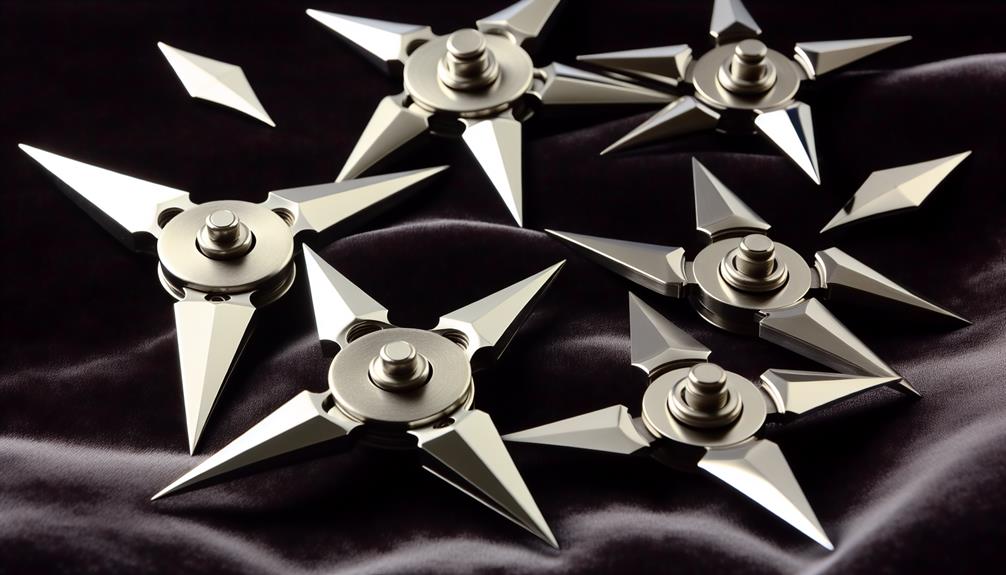
As you explore throwing stars, remember that durability isn’t just about longevity; it’s crucial for maintaining performance too.
You’ll find that the materials used significantly affect how long your stars can last without breaking.
Proper maintenance will ensure they remain effective and safe over many uses.
The material used to craft throwing stars significantly affects their durability and overall performance.
You’ll find that the choice of material isn’t just about aesthetics; it’s crucial for ensuring that your throwing star can withstand repeated use without deteriorating. Different material types offer varying degrees of impact resistance, which is a key factor in their longevity.
Here’s a quick rundown of what you should look out for:
Understanding the balance between durability and performance is crucial when choosing a throwing star. You might think it’s all about how sharp or sleek the star is, but if it can’t withstand repeated use, it’s hardly worth your investment.
Durability standards are just as important as performance metrics. That’s why you need to consider both when selecting your ideal throwing star.
Durability ensures that the star retains its shape, sharpness, and overall integrity after multiple throws. Performance, on the other hand, encompasses how accurately and efficiently the star can hit a target.
Often, a more durable star mightn’t initially seem as sharp or fast as less sturdy alternatives, but over time, its consistent performance proves invaluable.
When you’re evaluating throwing stars, look at the materials and construction. These factors typically dictate how well the star will perform over repeated use.
You’ll find that high-durability stars can save you from frequent replacements, which actually gives you a better return on your investment.
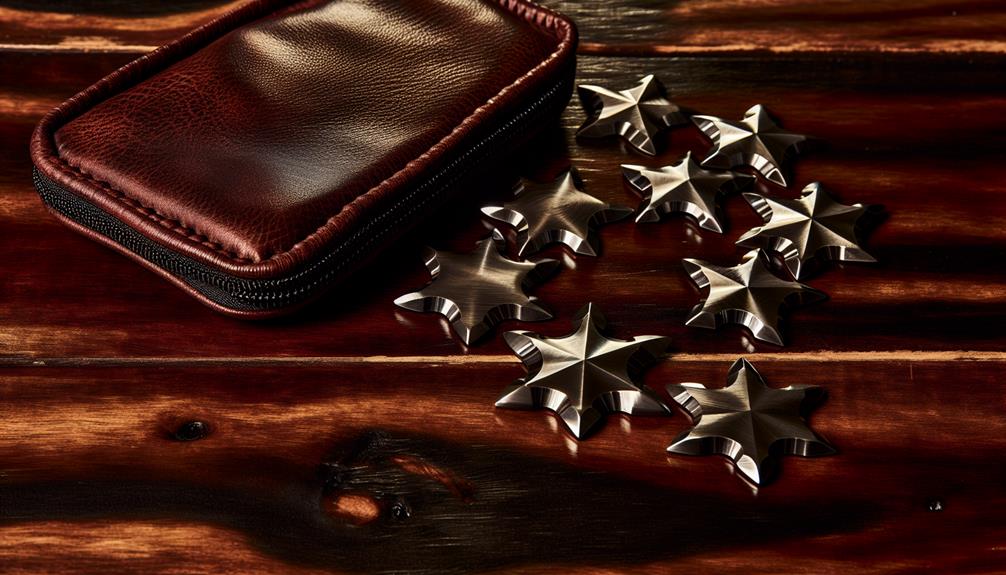
Maintaining your throwing star’s durability isn’t just about keeping it clean; regular upkeep ensures it performs well for years to come.
To achieve this, you’ve got to adopt a comprehensive maintenance routine that includes proper cleaning techniques and storage solutions.
Here’s how you can ensure your throwing stars remain in top condition:
For a deeper clean, use a mild soap and water solution, then dry thoroughly to prevent rust.
These imperfections can affect performance and might even be dangerous during use.
This protects them from environmental factors and keeps them organized and safe when not in use.
This includes re-sharpening the edges to ensure they’re always ready for action.
When selecting throwing stars, you’ll find that manufacturers often choose materials known for their strength and durability. Among these, steel alloys and titanium blades are particularly favored for their robustness and ability to withstand the rigors of repeated use. Composite materials, including modern plastics and carbon fiber, are also popular, providing a lightweight yet sturdy option that’s perfect for precision throwing.
These materials not only need to be strong but also resistant to wear and tear. That’s why heat treatment processes and surface coatings are crucial to enhance the performance and longevity of throwing stars. Traditional metals continue to be used, but they are often combined with these newer technologies to improve their properties.
Here’s a quick overview of the materials used:
| Material | Properties | Common Uses |
|---|---|---|
| Steel Alloys | High strength, durable, heat treated | Core of many blades |
| Titanium | Lightweight, strong, corrosion-resistant | Premium models |
| Carbon Fiber | Extremely lightweight, strong | Handles, decorative parts |
| Modern Plastics | Resistant to impact, versatile | Training throwing stars |
Choosing the right material depends on your needs, whether it’s for competition, practice, or collection. Each material offers unique benefits, so consider what’s most important for your throwing star’s performance and longevity.
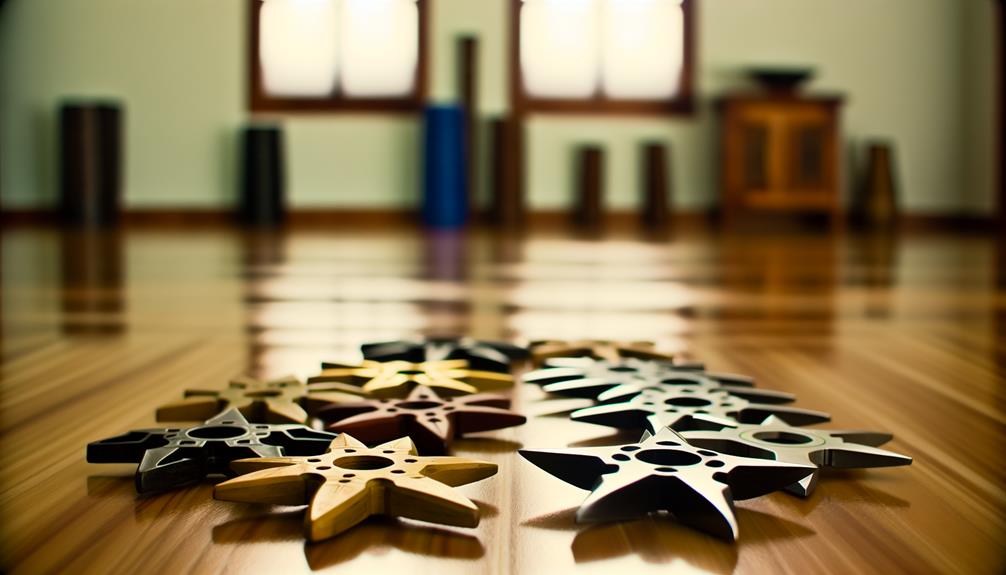
To craft high-quality throwing stars, skilled artisans employ various techniques that depend heavily on the choice of material.
You’ll find that the intricacies of these methods aren’t just about shaping metal but also about enhancing the star’s throwing techniques and ensuring its longevity.
Here’s what you need to know to make your own durable throwing stars:
If you’re looking for throwing stars that combine longevity with superior design, several models stand out due to their robust construction and meticulous craftsmanship.
Among the best brands, the Zenith Shuriken Series is frequently praised in user reviews for its resilience under frequent use. Crafted from high-grade steel, each star in the series undergoes a rigorous tempering process that significantly enhances its durability.
Another standout is the Orion Tactile Model, lauded for its weighted balance and exceptional hardness. Users often note how these stars maintain their sharpness and structural integrity even after multiple throws, attributing this to the unique alloy blend used in their manufacturing.
The Shadow Master Collection also receives high marks for durability. These stars feature a proprietary coating that not only resists corrosion but also minimizes the wear and tear from both weather and rigorous training sessions.
This collection is particularly favored by enthusiasts who value longevity as much as performance.
As you explore these options, you’ll find that investing in a well-crafted model not only enhances your practice but also ensures that your equipment stands the test of time.
Before you invest in a new set of throwing stars, it’s crucial to put them through rigorous performance testing.
You’ll want to ensure they meet high standards of durability and precision, which directly influence their effectiveness.
Here’s how you can conduct performance testing using specific testing methods and evaluating defined performance metrics:
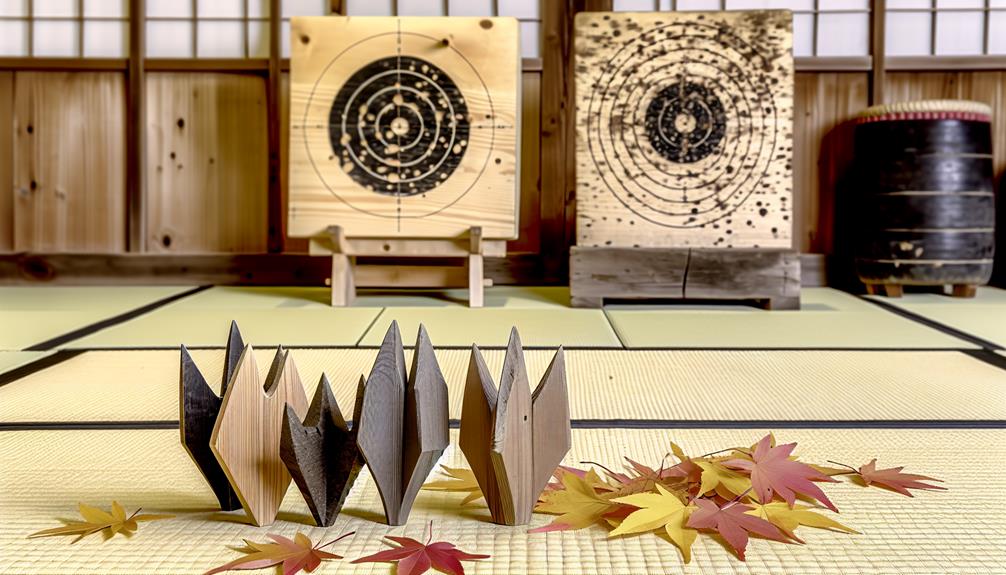
After ensuring your throwing stars perform optimally through rigorous testing, it’s important to focus on their care and maintenance to preserve their condition and extend their usability. Proper care involves specific cleaning techniques and using protective storage that shield your tools from environmental hazards.
Firstly, you need to clean your throwing stars after each use. This prevents buildup of residues that can corrode the metal. Use a soft cloth and a cleaner suitable for metal; avoid harsh chemicals that could damage the finish or integrity of the stars. After cleaning, ensure they are completely dry to avoid rusting.
For storage, choose options that protect them from moisture and dust. A lined box or a custom case with individual compartments works best. This prevents them from knocking into each other, which can cause chips or dullness.
Here’s a handy table to summarize the care and maintenance routine:
| Activity | Frequency | Details |
|---|---|---|
| Cleaning | After use | Wipe with a metal-friendly cleaner. |
| Drying | Immediately | Ensure completely dry before storing. |
| Inspecting | Monthly | Check for any signs of wear or damage |
| Storing | Constantly | Use protective, lined storage. |
| Conditioning | Yearly | Apply light oil to prevent rust. |
As you use your throwing stars, you’ll notice they aren’t immune to wear and tear.
The materials can degrade over time, raising concerns about their longevity and performance.
Let’s explore what causes these issues and how you can address them.
Despite their robust construction, throwing stars eventually succumb to wear and tear, a common issue that affects both their performance and safety.
You might’ve noticed your stars losing their edge or even small chips appearing after extensive use. This deterioration isn’t just about aesthetics; it impacts how effectively you can hit and penetrate your target.
Here’s what you need to look out for to assess wear and tear:
To keep your throwing stars in top shape, regular maintenance is essential.
Don’t let wear and tear compromise your practice or performance.
Understanding the materials used in your throwing stars is crucial as they dictate both performance and longevity. When selecting your throwing stars, you’ll encounter a variety of material types, each with its own set of pros and cons. Commonly used materials include stainless steel, carbon steel, and even titanium, each adhering to different durability standards.
One major concern with material breakdown is corrosion, particularly if you’re using stars made from lesser grades of steel. You’ve probably noticed rust or discoloration after exposure to moisture, which can seriously degrade the metal over time. It’s not just about aesthetics; this weakening can lead to reduced effectiveness in your throwing stars, impacting both their balance and sharpness.
Another issue lies in the brittleness of certain ceramics or lower-quality metals. Though they might initially seem adequate due to their lightweight nature, they can chip or shatter upon impact, especially if you’re practicing on harder targets.
To avoid these pitfalls, it’s best to invest in high-quality materials that meet high durability standards. Remember, the initial cost might be higher, but you’re saving on replacement costs and avoiding the hassle of frequent replacements.
With the right materials, your throwing stars will serve you well for many sessions to come.
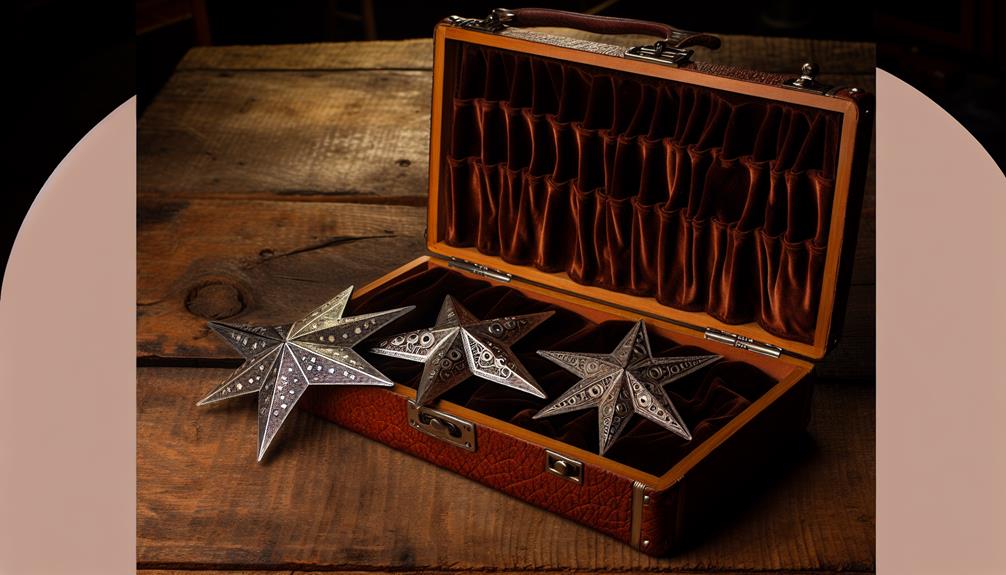
Enhancing the durability of throwing stars involves selecting the right materials and employing advanced manufacturing techniques. You want your stars to withstand numerous impacts without losing their edge or structural integrity. This isn’t just about choosing tough materials; it’s about understanding how design innovations can shape user experiences.
For instance, integrating composite materials can significantly bolster the lifespan of your throwing stars.
To truly enhance the durability of your throwing stars, consider the following:
These steps aren’t just about making your throwing stars last longer; they’re about enhancing your performance and satisfaction with each use.
Durability means reliability, and by focusing on these aspects, you’re investing in tools that won’t let you down when you need them most.
When you’re in the market for throwing stars, it’s crucial to understand how material quality affects durability.
You need to weigh the cost against performance to ensure you’re getting the best value for your money.
Additionally, consider the maintenance required to keep your throwing stars in top condition.
Choosing the right material for your throwing stars is crucial to ensuring long-term durability and optimal performance. When you’re picking materials, consider these key differences between steel and aluminum, especially focusing on weight distribution, which greatly affects how your throwing star performs.
Here’s what you need to keep in mind:
Aluminum stars might feel lighter, which can be a pro or con depending on your throwing style.
Aluminum is naturally rust-resistant, making it a low-maintenance option.
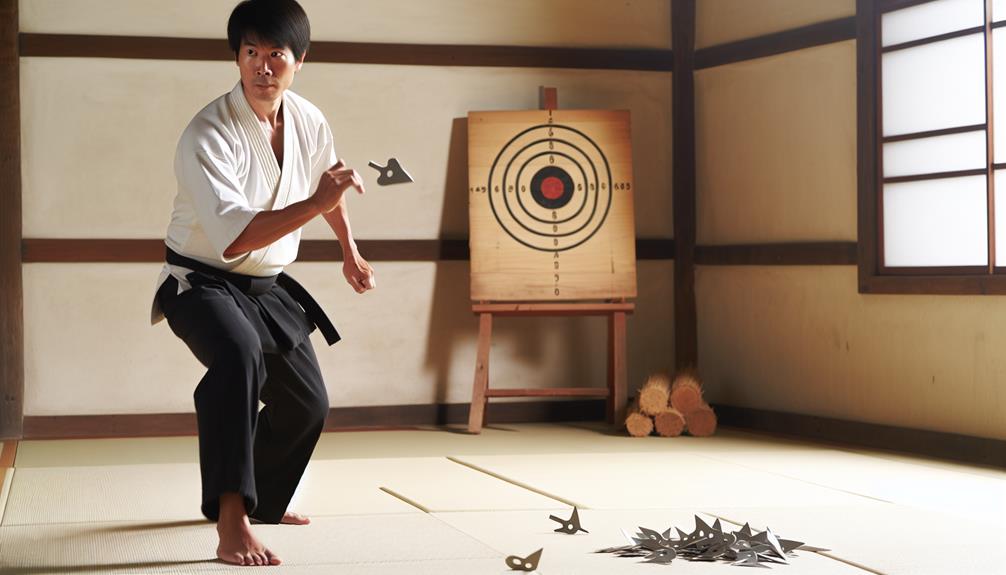
While material quality greatly impacts the durability and feel of throwing stars, you should also weigh the cost against potential performance gains. Conducting a thorough cost analysis ensures you’re not overpaying for features that don’t enhance your throwing experience.
Cheaper models might tempt you, but remember, lower prices often reflect inferior materials that mightn’t withstand rigorous use.
When you’re comparing models, focus on value comparison rather than just sticker price. Ask yourself how each throwing star stands up to the demands of frequent practice or competition. For example, a moderately priced star with proven durability and excellent balance offers more value than a cheaper, poorly made alternative.
Don’t let flashy marketing sway you; stick to products with reputable reviews and trusted user feedback.
Investing in a higher-priced model might seem steep initially, but it can be more cost-effective in the long run. These stars typically offer better materials and craftsmanship, which translate to enhanced performance and longevity.
You’ll save money on replacements and enjoy a more satisfactory practice or competition experience. Always balance your budget with your performance needs to find the best option for you.
Proper care of your throwing stars ensures they remain in top condition, extending their lifespan and maintaining performance. To help you keep your throwing stars in pristine shape, here’s a straightforward guide that highlights effective cleaning techniques and storage solutions.
For a deeper clean, occasionally use a mild detergent diluted with water, but make sure you dry them thoroughly afterward to prevent rust.
This not only keeps the metal lubricated but also forms a barrier against moisture and rust. Ensure it’s a thin layer to avoid gunk buildup which can affect the star’s flight.
Invest in a dedicated storage solution that keeps them secure and separated. Fabric-lined cases or magnetic strips are great options that prevent scratches and dents.
This includes checking the tips for bluntness and the edges for nicks or cracks. Early detection of issues means easier maintenance and longer usability.
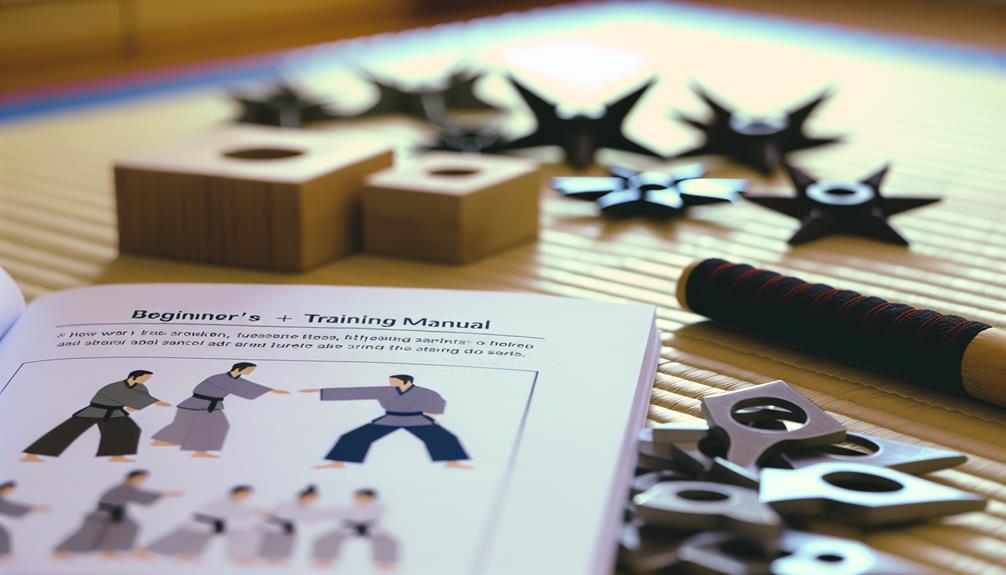
No, throwing stars aren’t legal to own and use in all countries.
Their legality varies based on local laws, cultural significance, and historical origins. For instance, in some places, they’re considered weapons and are strictly regulated or banned.
You’ll find these tools legal in countries where they’re part of cultural heritage.
Always check your local laws to ensure you’re not violating any regulations if you’re interested in owning or using throwing stars.
You can use throwing stars for self-defense, but their effectiveness depends heavily on your skill with throwing star techniques.
They’re not the most practical choice due to the precision and training required. If you’re considering them for protection, it’s crucial to practice extensively and understand the limitations and legalities in your area.
Other self-defense tools might offer more reliability and ease of use in urgent situations.
You’ll find that age restrictions for purchasing throwing stars vary by location, but typically, you must be at least 18 years old.
Sellers often require age verification to ensure responsible ownership.
It’s essential to check local laws and regulations before buying or carrying throwing stars, as they can be considered weapons.
Always remember that owning such items comes with a responsibility to handle them safely and legally.
Yes, there are competitive sports and leagues for throwing star enthusiasts like you.
These events focus on honing throwing techniques and measuring precision and skill. You can join local clubs or national organizations that host tournaments throughout the year.
Whether you’re a beginner or an expert, these competitive events offer a platform to showcase your abilities and connect with others who share your passion for throwing stars.
Weather conditions significantly impact your throwing star performance. High humidity can affect the material durability, causing them to wear down faster.
Rain might make the stars slip during release, altering throwing techniques. Similarly, windy conditions can deviate their trajectory, demanding adjustments in how you aim and throw.
It’s crucial to adapt your handling and technique based on these environmental factors to maintain accuracy and ensure the longevity of your stars.
You’ve explored the robust world of throwing stars, from their storied past to the art of their creation. Opting for models crafted from resilient materials like steel alloys or titanium will guarantee high performance and endurance. Remember, regular care is crucial; keep them clean and inspect them often. Address common issues swiftly to enhance durability. With these tips, you’re ready to choose the best throwing star that promises both historical authenticity and lasting value. Happy throwing!
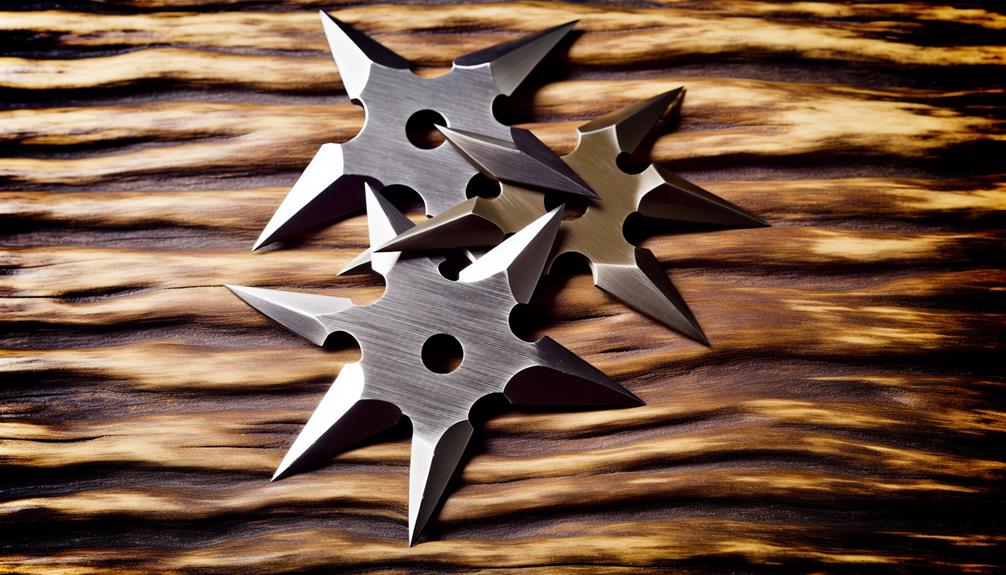
Brainstorm Security Shop
1867 Caravan Trail
Ste 105
Jacksonville, FL 32216
Call us toll free: (800) 859-5566